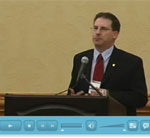Halifax Job Search Strategies Forum Report
Transitioning from School to Work
| Video |
 |
Shawn Thompson, Diversity and Workplace Equity, BMO Financial Group
“You have to think of yourself as the Chief Marketing Officer of You, as you go out and promote yourself to potential employers,” said Shawn Thompson. A solid career plan has four parts: building a professional brand, identifying strengths and opportunities for development, setting career goals, and setting the plan in action.
Self-assessment is the foundation of any career plan, yet it is often given little or no consideration, Thompson said. For a career plan to succeed, self-assessment should be realistic and honest. Identifying personal values, interests, personality, and skills uncovers the characteristics that appeal to others, including employers.
Job seekers should make a list of their strengths and weaknesses, and invite people they know and trust to make a similar list. If the two lists differ greatly, more self-reflection is necessary.
Knowing oneself leads to the development of the most powerful self-promotional tool: personal brand. An individual builds a personal brand with professional cover letters, resumés, and personal networking.
“When you leave the room, what do you want people to say about you?” Thompson asked. “That is the brand you want to build.”
Thompson said body language helped him succeed in his first interview out of university. Leaning forward when answering questions set him apart from other applicants; it shows passion, confidence, and motivation. Now, as an interviewer, he looks for personal brand as well as answers to three questions:
- Why do you want to work for us?
- What do you know about our company’s goals and objectives?
- Do you understand and embrace our company culture?
Developing a personal brand will help applicants answer these questions. Details of a company’s operations and expectations can be found on the company website, and on the website of its industry association. For instance, a potential applicant to BMO might research the Canadian Bankers Association.
At trade shows Thompson sees many people who want a senior position with his organization. While aspirations are good, applicants must realize that most jobs for new graduates are entry-level. Promotions are possible, but they come with time and perseverance. Setting clear career goals will make this process more efficient. Thompson advised learning more about potential jobs by shadowing, mentoring, or volunteering in related fields.
The final step in the career plan is action: set specific tasks and timelines to reach short- and long-term goals.
Thompson commonly sees 200–300 applicants vying for a single job, so having a personal brand and researching the company are crucial to making an impression. Treat each application as a learning experience, regardless of the outcome, said Thompson. Be open to feedback, reflect, and make adjustments where necessary.

 Quick Question:
Quick Question:

